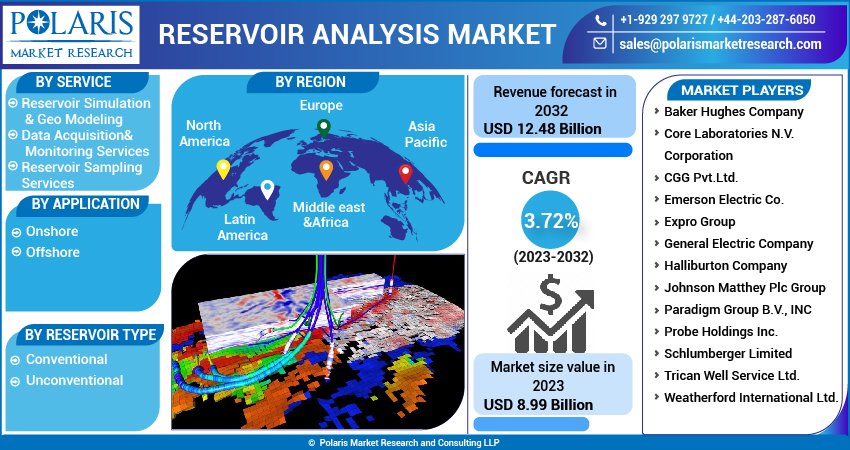According to the research report, the global Reservoir Analysis Market was valued at USD 8.78 billion in 2022 and is expected to reach USD 12.48 billion by 2032, to grow at a CAGR of 3.72% during the forecast period.
Reservoir analysis plays a vital role in the upstream oil and gas sector. It involves a detailed evaluation of subsurface reservoirs to assess their potential for hydrocarbon production. This multidisciplinary process includes well log interpretation, petrophysical analysis, and seismic data processing to model the reservoir’s size, shape, porosity, permeability, and saturation.
Market Overview
As global energy demand remains high and oil prices stabilize, oil and gas companies are intensifying exploration and production (E&P) activities, particularly in untapped and unconventional reservoirs. These efforts are increasing the demand for reservoir analysis services that provide critical data to optimize field development plans and minimize operational risks.
Reservoir analysis is not only critical during the exploration phase but also throughout the production lifecycle. It enables enhanced oil recovery (EOR), reduces uncertainties, and ensures efficient use of capital. Furthermore, oilfield reservoir modeling is becoming increasingly accurate due to digital twin technologies and AI-powered data interpretation, making this market more attractive to investors and stakeholders.
Market Segmentation
The Reservoir Analysis Market can be segmented based on services, reservoir type, application, and geography.
- By Services
- Well Log Interpretation: This segment remains a cornerstone of reservoir analysis, providing insights into lithology, fluid content, and reservoir continuity. Sophisticated digital logging tools are now enabling high-resolution data collection from complex formations.
- Seismic Data Processing: This involves the use of 2D, 3D, and now increasingly 4D seismic surveys to map subsurface structures and monitor reservoir behavior over time. It is essential for identifying drilling locations and tracking fluid movements.
- Petrophysical Analysis: With the advent of advanced core sample analysis and machine learning algorithms, this segment is gaining momentum. Petrophysical studies help determine rock properties, fluid saturations, and reservoir productivity.
- Reservoir Simulation and Modeling: Tools for oilfield reservoir modeling help operators visualize and forecast reservoir performance under different operational scenarios. These models are now integral to EOR planning and risk mitigation strategies.
- By Reservoir Type
- Conventional Reservoirs: This segment continues to dominate the market as it includes mature fields that require ongoing analysis for secondary and tertiary recovery.
- Unconventional Reservoirs: Growing interest in shale gas, tight oil, and coal bed methane is pushing demand for specialized analysis services, especially in North America and China.
- By Application
- Onshore: Onshore projects, especially in North America and the Middle East, are major contributors to market revenue due to their accessibility and cost-effectiveness.
- Offshore: The offshore segment, particularly in deepwater and ultra-deepwater regions, is expected to witness high growth due to the complexity of operations that demand extensive reservoir evaluation.
- By Geography
- North America: The U.S. remains the largest market, driven by shale gas exploration, ongoing digital transformation in oilfields, and a mature ecosystem of technology providers.
- Middle East & Africa: High potential reserves in Saudi Arabia, UAE, and offshore Africa make this a key region for reservoir analysis service providers.
- Asia-Pacific: Countries like China, India, and Indonesia are ramping up investments in E&P, creating new opportunities for advanced seismic imaging and modeling.
- Europe: The North Sea remains a critical zone, particularly with the emergence of digital twins and enhanced simulation technologies for aging fields.
- Latin America: Brazil and Argentina are increasingly adopting reservoir evaluation technologies to exploit pre-salt and shale resources, respectively.
𝐄𝐱𝐩𝐥𝐨𝐫𝐞 𝐓𝐡𝐞 𝐂𝐨𝐦𝐩𝐥𝐞𝐭𝐞 𝐂𝐨𝐦𝐩𝐫𝐞𝐡𝐞𝐧𝐬𝐢𝐯𝐞 𝐑𝐞𝐩𝐨𝐫𝐭 𝐇𝐞𝐫𝐞:
https://www.polarismarketresearch.com/industry-analysis/reservoir-analysis-market
Key Companies in the Reservoir Analysis Market
The competitive landscape of the Reservoir Analysis Market is defined by a mix of global oilfield service giants and specialized technology firms. These companies focus on innovation, strategic alliances, and integrated service offerings to maintain and expand their market presence.
- Baker Hughes Company
- Core Laboratories N.V. Corporation
- CGG Pvt.Ltd.
- Emerson Electric Co.
- Expro Group
- General Electric Company
- Halliburton Company Johnson Matthey Plc Group
- Paradigm Group B.V. INC
- Probe Holdings Inc.
- Schlumberger Limited
- Trican Well Service Ltd.
- Weatherford International Ltd.
Recent Developments
In December 2022, Dome Principals Kappa and Amarile were awarded two major software contracts by ADNOC Offshore. As part of the agreement, Kappa will provide ADNOC with its “Reservoir Software Management Systems,” including TOPAZ, EMERAUDE, and SAPHIRE. Amarile, known for supporting reservoir engineers, will contribute solutions that streamline and optimize workflows for field dynamic simulation.
Technological Advancements Driving the Market
Digital transformation is reshaping the Reservoir Analysis Market, with key technologies playing a vital role:
- Artificial Intelligence and Machine Learning: AI is being deployed for pattern recognition in well logs and seismic data, significantly reducing interpretation time and improving accuracy.
- Cloud Computing and Big Data: These technologies enable collaborative reservoir modeling and real-time data sharing among stakeholders across the globe.
- Augmented Reality and Virtual Reality (AR/VR): Some companies are leveraging AR/VR to create immersive reservoir simulations, aiding in training and planning.
- Integrated Reservoir Management: The convergence of petrophysical, geological, and production data into unified platforms is enabling better decision-making and reservoir optimization.
Outlook and Opportunities
The global energy sector is at a crossroads, balancing fossil fuel dependency with the transition to renewable sources. In this context, efficient hydrocarbon extraction is critical. The Reservoir Analysis Market is uniquely positioned to support this goal by offering tools and insights that enhance recovery rates and extend field life.
Opportunities exist not only in traditional oilfields but also in carbon capture and storage (CCS) projects, where reservoir analysis plays a key role in evaluating underground CO₂ sequestration sites.
Furthermore, as environmental regulations tighten, companies will be required to justify exploration activities with robust geological and geophysical data—providing an additional push for petrophysical analysis and seismic modeling solutions.
More Trending Latest Reports By Polaris Market Research:
Automotive Brake Systems Market
Biologics Contract Development Market
Digital Transaction Management

